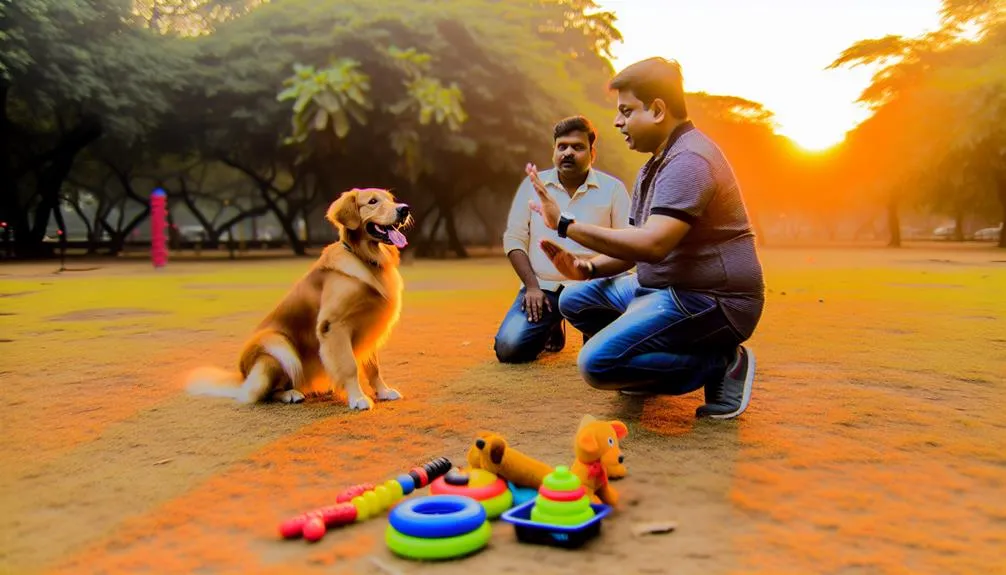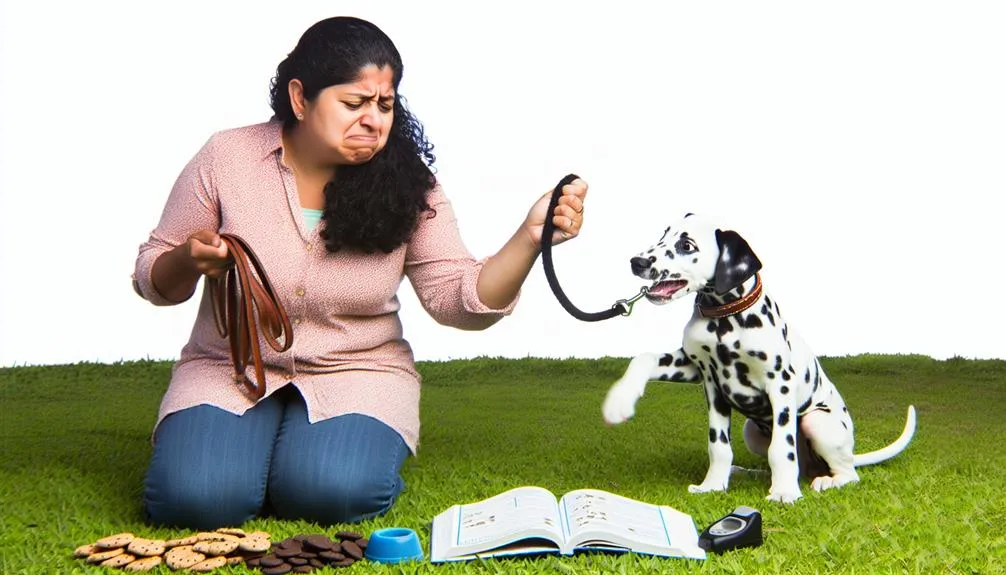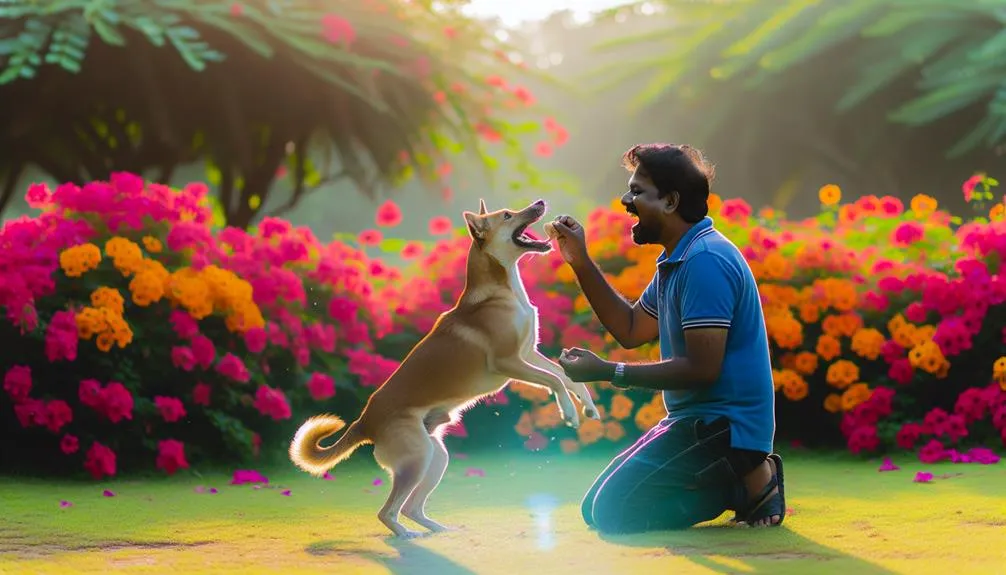
How to Train a Dog
Training a dog isn't just a task; it's a monumental journey that could rival any epic adventure. You might feel overwhelmed by the sheer number of techniques and tips available, yet it's vital to understand that successful training hinges on a few key principles. From recognizing your dog's unique behavior to mastering essential commands, the process can be both rewarding and frustrating. So, what's the secret to transforming your canine companion into a well-mannered member of the family?
Understanding Your Dog's Behavior
Understanding your dog's behavior is vital for building a strong bond and ensuring effective training. Dogs communicate primarily through body language and social cues, so paying attention to these signals is important. For instance, a wagging tail might indicate excitement, while cowering could signal fear. Recognizing these communication signals helps you respond appropriately to your dog's emotional state.
Environmental influences can also affect your dog's behavior. Changes in their surroundings, like new noises or unfamiliar people, may trigger Anxiety responses or instinctual behaviors. By observing how your dog reacts in different settings, you can identify potential fear triggers and manage them effectively.
It's important to take into account breed characteristics as well. Some breeds have specific play patterns and instinctual behaviors that dictate how they interact with the world. For example, herding breeds may exhibit chase behavior, while retrievers might enjoy fetching. Understanding these traits can help you tailor your training methods to suit your dog's needs.
Additionally, your dog's emotional state plays a significant role in their behavior. When they're anxious or stressed, they might struggle to focus on training. Being aware of your dog's feelings can guide you in creating a positive learning environment.
Lastly, always observe your dog's play patterns. Play can reveal a lot about their temperament and social skills. By understanding these aspects, you can foster a more engaged and responsive relationship with your furry friend, ultimately leading to more effective training.
Essential Training Supplies
When it comes to training your dog, having the right supplies can make all the difference. You'll need basic training tools, treats for motivation, and sturdy leashes and collars to guarantee control during your sessions. With these essentials, you'll set yourself and your dog up for success.
Basic Training Tools
Having the right tools at your disposal makes all the difference in effective dog training. First on your list should be a clicker. This small device produces a distinct sound that marks the exact moment your dog performs the desired behavior. It's a fantastic way to communicate and reinforces positive actions, making it an essential part of your training toolkit.
Next, consider a training schedule. Consistency is key in any training program, and having a structured plan helps keep both you and your dog on track. Set aside specific times each day to work on training exercises. This not only builds a routine but also strengthens the bond between you and your pup.
Don't forget about leashes and collars. A well-fitted collar provides control, while a sturdy leash guarantees safety during your training sessions. You might also want to invest in a training harness if your dog tends to pull.
Lastly, a notebook can be invaluable. Keeping track of your dog's progress and any challenges you face can help you adjust your training methods effectively. With these basic training tools, you're well on your way to successful dog training!
Treats and Rewards
Treats and rewards are essential supplies in your dog training arsenal, often making the difference between a distracted pup and an enthusiastic learner. Using treats effectively hinges on two main concepts: treat timing and reward variety.
Treat timing refers to the precise moment you give your dog a treat. It's vital to reward them immediately after they perform the desired behavior. This helps them associate the action with the reward, reinforcing good habits. If you wait too long, your pup might not connect the dots, leading to confusion.
Reward variety is equally important. Just like us, dogs can get bored with the same treats over time. Mixing up the types of treats you use can keep your dog's interest piqued and make training more enjoyable. Experiment with different flavors, textures, and even toys as rewards.
Leashes and Collars
Equipping your dog with the right leash and collar is essential for effective training and safety. You'll find that there are different leash types available, each serving a unique purpose. For instance, a standard flat leash is great for everyday walks, while a retractable leash offers more freedom for your pup to explore. If you're working on training, a shorter leash can help you maintain better control during sessions.
When it comes to collars, prioritize collar safety. Make certain the collar fits snugly but isn't too tight—two fingers should fit comfortably between the collar and your dog's neck. Consider using a flat collar for everyday wear and a training collar, like a martingale, for more controlled situations. Just be cautious with any training collars to guarantee they're used appropriately and don't cause harm.
Ultimately, the right leash and collar combination not only enhances your dog's training experience but also promotes a secure environment during your outings. Always remember to check the condition of your equipment regularly to keep your training sessions safe and effective. Happy training!
Basic Commands to Teach

Now that you've got your training supplies ready, it's time to focus on the basic commands every dog should learn. These essential commands not only improve your dog's behavior but also strengthen your bond with them. Let's explore effective training techniques to help you teach these commands with ease.
Essential Commands to Learn
When it comes to training your dog, mastering essential commands is crucial for effective communication and a harmonious relationship. These commands not only help you convey your expectations clearly but also enhance your dog's understanding of your cues. Here are some fundamental commands you should focus on:
| Command | Purpose | Tips for Training |
|---|---|---|
| Sit | Keeps your dog calm | Use treats and praise |
| Stay | Teaches patience | Start with short duration |
| Come | Guarantees safety | Always reward when they come |
| Down | Promotes relaxation | Use a gentle approach |
Training Techniques Overview
Building on the foundation of basic commands, understanding the training techniques that can help you teach these skills effectively is key. One popular method is clicker training, which uses a distinct sound to mark desired behaviors, helping your dog connect actions with rewards. This form of positive reinforcement can enhance your canine's learning experience and make training more engaging.
Incorporating socialization skills early on is essential, as it prepares your dog to interact well with others. Consider enrolling in obedience classes, where you can both learn together and meet other dog owners. Establishing a consistent training schedule can also reinforce learning, emphasizing the importance of consistency in your commands and expectations.
When training, be mindful of distractions that may affect your dog's focus. Tailoring your approach to your dog's learning style can enhance their understanding and retention of commands. Effective canine communication and handler engagement are critical components in building a strong bond, making your training sessions more productive. Finally, don't hesitate to use behavior modification techniques if needed, as these can help address specific issues and improve your dog's overall behavior.
Positive Reinforcement Techniques
Positive reinforcement techniques are among the most effective ways to train your dog, creating a strong bond built on trust and understanding. These methods focus on rewarding your dog for desired behaviors rather than punishing them for mistakes. This not only encourages good behavior but also fosters a positive learning environment.
Here are three effective positive reinforcement techniques you can implement:
- Clicker Training: Using a clicker can greatly enhance your training sessions. This small device makes a distinct sound when your dog performs the desired behavior. Immediately follow the click with a reward, like a treat or praise, to reinforce that behavior. Over time, your dog will associate the click with positive outcomes.
- Behavioral Shaping: This technique involves breaking down complex behaviors into smaller, achievable steps. Start by rewarding your dog for partial completion of the task and gradually increase the expectations. For instance, if you're teaching them to sit, you can reward them for merely lowering their butt before they fully sit.
- Treat and Praise: Always keep some treats handy during training sessions. When your dog successfully performs a command, reward them right away with a treat and enthusiastic praise. This combination strengthens their enthusiasm to repeat the behavior.
Addressing Common Challenges

Training a dog can sometimes come with its share of challenges, even when using positive reinforcement techniques. You'll likely encounter common issues like barking, leash pulling, and jumping up that can test your patience. Recognizing these challenges early can help you address them effectively.
Here's a quick overview of some common challenges:
| Challenge | Description | Tips for Resolution |
|---|---|---|
| Separation Anxiety | Dogs may become anxious when left alone. | Create a safe space and use toys. |
| Barking Issues | Excessive barking can be disruptive. | Teach a "quiet" command. |
| Leash Pulling | Dogs often pull on the leash during walks. | Use a front-clip harness. |
| Chewing Problems | Destructive chewing can be a sign of boredom. | Provide chew toys and mental games. |
You might also face fear responses, which can lead to resource guarding—where your dog protects their food or toys. This behavior often stems from insecurity and can be managed with gradual desensitization. Additionally, focus on improving your dog's socialization skills to help them feel more comfortable in various environments.
Advanced Training Strategies
When it comes to taking your dog's skills to the next level, advanced training strategies can make all the difference. These techniques not only enhance your dog's abilities but also strengthen your bond through engaging activities. Here are three effective methods to take into account:
- Clicker Training: This positive reinforcement method helps your dog associate behaviors with rewards. Use the clicker to mark desired behaviors immediately, followed by a treat. This fosters precision in training and encourages your dog to repeat those behaviors.
- Distraction Training: Teaching your dog to remain focused amidst distractions is essential. Start in a quiet environment, gradually introducing distractions while maintaining your dog's attention. This builds impulse control and enhances handler focus, ensuring your dog can perform commands anywhere.
- Scent Work and Agility Training: Both of these activities challenge your dog's mind and body. Scent work taps into your dog's natural instincts, while agility training improves coordination and confidence. Incorporate problem-solving games to keep your dog mentally stimulated and engaged.
Don't forget to include socialization exercises throughout your training. Exposure to different environments and other dogs will help your pup become well-rounded and adaptable. By embracing these advanced strategies, you'll not only refine your dog's skills but also deepen your connection as you tackle exciting challenges together.
Building a Strong Bond

Building a strong bond with your dog is fundamental for effective communication and mutual trust. When you invest time in trust building, you're laying the groundwork for a relationship that enhances both training and companionship. Dogs thrive on connection, so engaging in activities that foster this bond is essential.
Start by spending quality time together. Daily walks not only provide physical exercise but also expose your dog to new environments and experiences, which helps develop their socialization skills. Allowing your dog to explore their surroundings while keeping a close eye on them builds their confidence, knowing they can rely on you for guidance.
Positive reinforcement is another significant aspect of trust building. Use treats, praise, or toys to reward desired behaviors, reinforcing the idea that you're a source of good things. This technique not only strengthens your bond but also encourages your dog to look to you for direction.
Engaging in playtime is also important. Whether it's a game of fetch or tug-of-war, these interactions help your dog associate you with fun and safety. It's a fantastic way to break down barriers and cultivate trust.
Lastly, be consistent in your interactions. Dogs thrive on routine, and knowing what to expect from you fosters security. Remember, the stronger your bond, the more effective your training will be. By prioritizing trust building and socialization skills, you're ensuring that you and your dog enjoy a fulfilling relationship that lasts a lifetime.
Frequently Asked Questions
How Long Should Training Sessions Last for My Dog?
For effective training, the ideal session length is 5 to 15 minutes, depending on your dog's age and focus. Remember, shorter sessions keep their attention. Use these training duration tips to maximize learning and retention.
Can I Train an Older Dog Effectively?
Absolutely, you can train an older dog effectively! With patience and positive reinforcement, your older dog can learn new tricks and commands. Remember, consistency and encouragement are key to making the training enjoyable for both of you.
What Are the Signs of Stress in My Dog During Training?
Did you know that 70% of dogs show stress signals during training? Watch for whining behavior, tail posture, body language, pacing movements, vocalization cues, avoidance signals, excessive panting, and ear position to gauge your dog's comfort.
How Often Should I Train My Dog Each Week?
You should aim for training consistency by practicing a few short sessions each week. Training frequency is key; daily or every other day works best to reinforce skills and keep your dog engaged and learning effectively.
Should I Train My Dog Indoors or Outdoors?
Imagine learning to dance in a crowded room—indoor distractions can be overwhelming. Training outdoors offers varied environments that help your dog focus better, while indoor sessions can refine skills in a controlled setting. Balance both for success!
Conclusion
Training your dog is like weaving a tapestry of trust and communication. Each command you teach strengthens your bond, creating a colorful pattern of shared experiences and understanding. Remember, patience and consistency are your threads; with positive reinforcement, you'll craft a masterpiece of companionship. Embrace the journey, celebrate the small victories, and watch as your efforts blossom into a harmonious relationship. Together, you and your dog can navigate the world, side by side, in perfect sync.
You may also like
Archives
Calendar
| M | T | W | T | F | S | S |
|---|---|---|---|---|---|---|
| 1 | 2 | 3 | 4 | 5 | 6 | |
| 7 | 8 | 9 | 10 | 11 | 12 | 13 |
| 14 | 15 | 16 | 17 | 18 | 19 | 20 |
| 21 | 22 | 23 | 24 | 25 | 26 | 27 |
| 28 | 29 | 30 | ||||
Leave a Reply